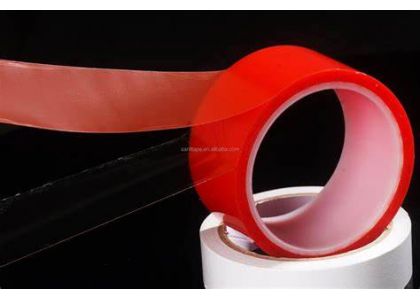
Working with low surface energy (LSE) materials like polypropylene, polyethylene, or powder-coated metals often means struggling with poor adhesive bonding. These materials resist wetting, making it difficult for traditional adhesives to form reliable contact. That’s where PET-based double sided tape steps in. Engineered with advanced acrylic systems, this solution adheres to LSE surfaces with exceptional grip and long-term stability. For industries looking to eliminate failure points in assembly, this type of tape is transforming bonding strategies. Paired with tools like industrialdouble sided adhesive tape, high tack double sided tape, and PET double sided adhesive bonding tape, manufacturers are finding more reliable, cleaner, and faster ways to build.
Low surface energy materials repel adhesives. Their chemical structure resists bonding agents from penetrating or anchoring, which leads to peeling, delamination, or complete failure over time. In high-volume manufacturing, that’s a costly risk.
For example, thermoplastics such as HDPE or TPO are commonly used for their durability and flexibility, but they pose bonding challenges that slow down production or require expensive surface treatments.
By using PET-based double sided tape, engineers bypass these limitations. These tapes combine strong acrylic adhesives with PET film carriers, delivering the performance needed to secure LSE components without priming or surface abrasion.
The base of PET double sided adhesive bonding tape is polyethylene terephthalate—a dimensionally stable, temperature-resistant material. It maintains integrity under load and environmental stress. When layered with pressure-sensitive adhesives, it forms a robust bond on surfaces that most tapes can’t handle.
Combine that with industrial double sided adhesive tape engineered for high initial tack, and the result is a bonding solution that grabs quickly and holds fast. In electronics, appliances, or automotive interiors, that immediate adhesion improves assembly speed while cutting back on rework.
 is critical in LSE applications. High tack means the adhesive aggressively grips the surface with little or no pressure, a major advantage when materials are sensitive to heat or pressure.
is critical in LSE applications. High tack means the adhesive aggressively grips the surface with little or no pressure, a major advantage when materials are sensitive to heat or pressure.
A key strength of PET-based double sided tape is its compatibility with such adhesives. The combination allows for strong anchoring on oily or waxy plastics where liquid glues would fail. It’s also ideal for high-throughput assembly lines where workers can’t spend extra seconds applying force or primers.
Manufacturers love these tapes not only for their performance but also for their simplicity. With double sided pet film tape, there’s no need to wait for curing or invest in plasma treatments. The liner peels cleanly, the tape applies in seconds, and the component is ready for the next step.
In industries where time is critical—like automotive trim lines or electronics module assembly—this clean, immediate bond means higher efficiency and fewer failures. PET double sided adhesive bonding tape helps cut down scrap rates, eliminate messy glues, and meet tight tolerances.
A major appliance manufacturer used PET-based double sided tape to mount plastic trim onto curved powder-coated panels. Prior to switching from glue to tape, 22% of units required rework due to adhesive failure. After integrating the tape, rework dropped to under 2%, saving over $100,000 annually in time and materials.
An electronics assembler adopted high tack double sided tape for bonding battery insulation sheets to textured polycarbonate. The result: a 40% reduction in labor time and consistent adhesion across product batches.
These aren’t just edge cases—they reflect what’s happening across manufacturing. As engineers demand cleaner production and better reliability, PET double sided adhesive bonding tape continues to outperform legacy bonding methods.
Adhesion strength is important, but staying power is critical. LSE materials often go into environments with heat, moisture, or UV exposure. PET-based double sided tape is designed to survive those conditions.
Its PET carrier won’t stretch or degrade, and the acrylic adhesive holds its properties over years. Industrial double sided adhesive tape rated for LSE bonding has been tested to maintain grip through 1,000-hour humidity and temperature cycling without lift or edge curl.
Whether the application is interior car components or moisture-prone appliances, these tapes bring long-term peace of mind to manufacturers and end-users alike.
The challenge of bonding LSE materials isn’t going away—these substrates are only becoming more common. But outdated methods like flame treatment, chemical primers, or heat activation slow down production and add safety risks.
With the right adhesive tech—specifically PET-based double sided tape and PET double sided adhesive bonding tape—manufacturers get the fast, clean, and dependable performance they need without the hassle. These tapes turn difficult bonding tasks into simple, repeatable steps.
In industrial manufacturing, every second and every bond counts. If your assembly process involves difficult plastics or coated metals, switching to or industrial double sided adhesive tape may be the upgrade you’ve been looking for.
From electronics to transportation, PET-based double sided tape is redefining what’s possible with LSE surfaces. It’s not just about adhesion—it’s about transforming limitations into opportunities.